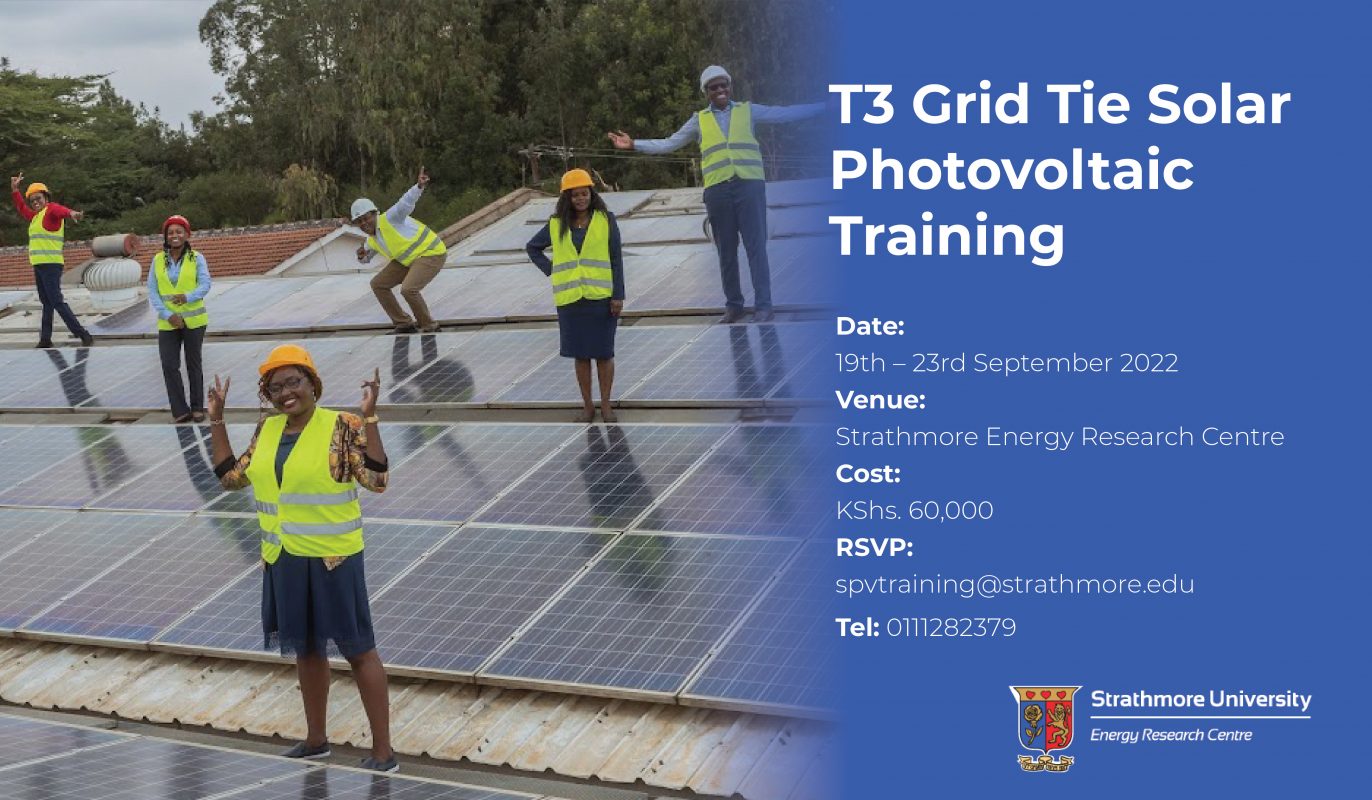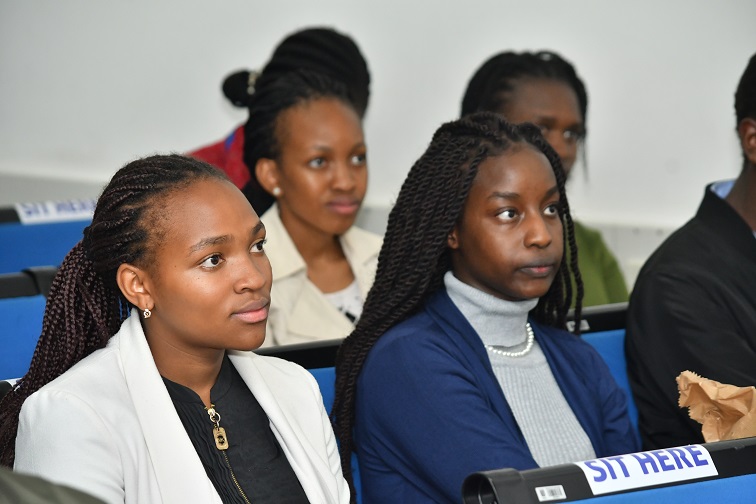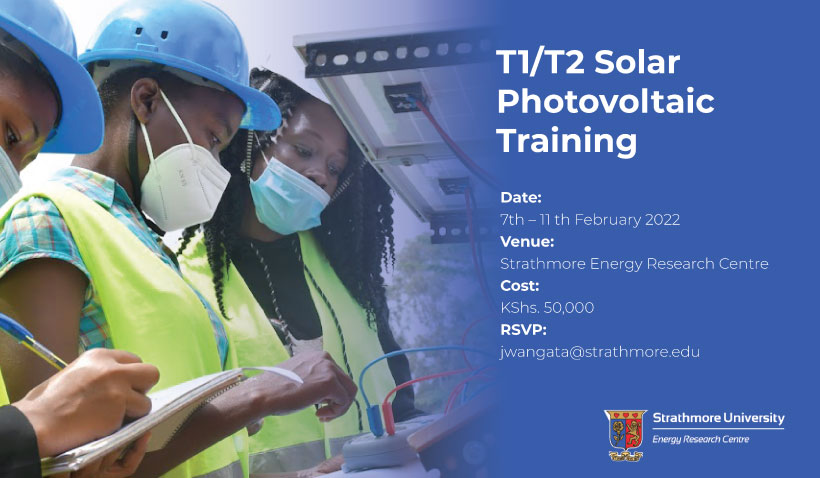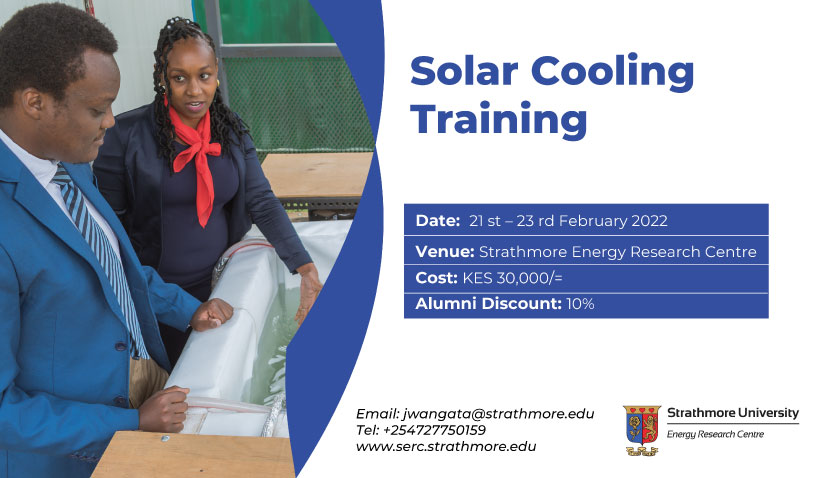
Date: 19th – 23rd September 2022
Venue: Strathmore Energy Research Centre
Cost: KES 60,000/=
email: spvtraining@strathmore.edu
Tel: +254111282379

Date: 19th – 23rd September 2022
Venue: Strathmore Energy Research Centre
Cost: KES 60,000/=
email: spvtraining@strathmore.edu
Tel: +254111282379

Innovation, ingenuity and intelligence headlined this year’s first Research Brown Bag, held on 6th May at iLabAfrica. Second-year Electrical and Electronics Engineering students, Joy Muntet and Esther Mugambi (pictured above, right and left respectively), jumped at the opportunity to present their project in front of their peers, researchers and industry professionals.
Earlier this year, the duo took part in Kenya’s first i-Teams program. The undertaking, which is spearheaded by Cambridge University and the Centre for Global Equality, in partnership with the Strathmore Energy Research Centre and the School of Computing and Engineering Sciences, is a breeding ground for young innovators. In their time with them, Muntet and Mugambi procured commercialization, communication, entrepreneurship, and technological competencies. “Participating in the Brown Bag felt like a natural segue after gaining indispensable knowledge and skills as part of i-Teams,” Muntet said. “The experience with i-Teams sparked an unquenchable thirst for innovation within us,” Mugambi added.
Noting the ever-growing concerns over food insecurity and erratic weather patterns, the twosome proposed a low-cost smart solar powered irrigation system that would countervail these issues. “I’m from Narok, which is a semi-arid region. Many of the farmers rely on the long and short rains to irrigate their crops. However, in the past couple of years, the seasonal cycle has become unreliable. This has had a devastating effect on their yields. We hope that our device will resolve this problem,” Muntet explained.
The system will consist of: a tank for storing water; a solar-powered pump; a series of pipes, which will be used to disseminate water across the farm; and moisture sensors to maintain the optimum water content of the soil by regulating the amount that is being pumped. Despite being students, Mugambi and Muntet are working tirelessly to ensure that their product graduates from infancy to a full-fledged irrigation system installed in the farms of thousands of Kenyans. “Although we are currently at the planning and design phase, we do not intend to linger here. Esther and I aspire to have the apparatus developed and in circulation by 2024,” Muntet revealed.
More than two centuries ago, Voltaire, a French writer, posed the question: Is there anyone so wise as to learn from the experiences of others? Indubitably, Muntet and Mugambi are. The partners’ Brown Bag presentation was evocative of an eagerness to learn. They not only fielded questions but also welcomed suggestions. “The cross-examination of our project helped enlighten us to the improvements we can make to the irrigation system to ensure it fulfils our target market’s needs. Had we not partaken in the Brown Bag, we might have remained ignorant to the refinements we can make to the product and we would likely have encountered impediments when trying to bridge the gap between lab development and market circulation,” Mugambi said.
Muntet concluded by sharing words of advice for other hopeful entrepreneurs, “You can’t wait around for the right time and right place. Sometimes you have to go out into the world and look for it. Opportunities are all around us, and it’s up to you to decide whether you’re the right person to take them up.”
This article was written by Laura Namuliro.

Date: 14th – 18th February 2022
Venue: Strathmore Energy Research Centre
Cost: KES 60,000/=
email: jwangata@strathmore.edu
Tel: +254727750159

Date: 7th – 11th February 2022
Venue: Strathmore Energy Research Centre
Cost: KES 50,000/=
email: jwangata@strathmore.edu
Tel: +254727750159

Only four counties out of forty-seven have attempted to develop energy plans in compliance with Kenya’s regulatory framework. This new regulatory framework was ushered in by a new constitution in 2010 which created and forty-seven devolved governments (counties). The counties were operationalised in 2013. Following this, the government of Kenya ratified a new Energy Act in 2019, to align the energy sector with the new constitution. In this new regulatory framework, counties are now mandated to develop energy plans and submit them to the national government through the Ministry of Energy for amalgamation into a national plan referred to as the Integrated National Energy Plan.
Development of energy plans by counties presents an opportunity to develop plans that are responsive to the varying energy needs of people in different contexts evidenced by unique economic activities and cultures. Furthermore, it provides an opportunity to accelerate energy access in connection to the sustainable development goals, especially goal 7 described by the pillars of access to affordable, reliable and clean energy . Counties however have limited technical capacity, sparse data, and resource constraints that present a challenge to fulfilling their energy planning mandates. These challenges will now be discussed further below.
There is a dearth of granular data that can be used to develop energy plans. Counties therefore must identify their data needs and undertake data collection which is an expensive process. Limited financial resources may therefore be a barrier for counties in undertaking this process. According to the Draft Kenya Integrated Energy Planning Framework (a policy document developed by the Ministry of Energy to guide energy planning), counties are required to plan for electricity access, transition to clean cooking, productive use of energy as well as energy efficiency. They are also required to plan for projects which will contribute to the aforementioned sectors and indicate sources of funding. This process must be informed by data to make the energy plan accurate. It is also worth noting that planning for transition to clean cooking fuels and technologies requires biomass to be incorporated into the energy plan. Planning for biomass is new in the Kenyan context therefore a methodology needs to be developed which countries can use to plan for biomass energy in general and transition to clean cooking in particular.
A study undertaken by the Sustainable Energy Technical Assistance Project funded by the EU revealed that counties required capacity building to enable them to prioritise their energy docket. Majority of county officials did not understand the linkages between energy and other developmental priorities such as water, health, and education. They therefore did not work in collaboration. Further, the energy docket was understaffed sometimes with only one energy officer in some cases. The SETA assessment also indicated that some counties do not have political will or buy-in to the process of developing energy plans. This could be partly due to limited technical capacity and financial resources which causes counties to under-value energy planning.
Counties also have limited capacity to utilise tools which can be used to analyse the data for the development of their energy plans. Further these tools are often based on proprietary software which are often costly. Open-source GIS based tools which consider spatial parameters are the best tools for counties to use as they develop their energy plans. They consider spatially varying characteristics such as population density, renewable energy resources, energy demand, power infrastructure and others therefore equipping counties to plan for energy access to the last mile.
There are a variety of initiatives being implemented to equip counties with the skills they require to undertake their mandates. Some of these include the Kenya Off-Grid Energy Access Project (KOSAP) and the SETA project. KOSAP is an initiative being implemented by the national government through funds received from the World Bank to extend energy access in marginalised areas. They will utilise off-grid technologies like mini-grids and solar home systems for this. County governments need to be equipped to discharge their mandates to enable this project to succeed. For example, the regulatory framework requires that they grant no-objections to mini-grid developers before they can be licensed by the Energy and Petroleum Regulatory Authority. These no-objections are granted based on site availability, alignment with the county development plans, and the mini-grid developers technical and financial capabilities. They therefore need to obtain an understanding of these technologies and understand their unique contribution to energy access. KOSAP has therefore directed county governments to identify their skills gaps and identify training institutions where they can receive capacity building. Other skills being focused on are environmental impact analysis, network design and regulation metering tariffs and pricing.
The SETA project on the other hand is entirely focused on equipping counties with the skills they require to develop their energy plans. In addition to training on the energy policy framework and cross cutting issues like gender, The SETA project is using the Energy Delivery Model, an end user focused planning tool developed by IIED, which can be used to identify county community needs and further break them down into energy and non-energy components. Using this process, counties can develop their energy plans based on community needs. SETA has used the approach in its initial Basic Training Program (BTP ) which targeted all the 47 counties in Kenya and introduced counties to the energy policy framework and process of energy planning. The project will shortly start implementing an Advanced Training Program (ATP) initially with a cohort of twelve counties which will provide more in-depth capacity building on theoretical and practical aspects of energy planning. Practical capacity building will be provided by selecting a model county and using their data to develop an energy plan. Counties participating in the advanced training program will be expected to mirror the process in their own localities. SETA also plans to appoint mentors for counties as they develop their energy plans so that they receive guidance from experts in the process.
A clear gap in the existing training programs is focus on tools that can be used for data analysis. Training on tools and the theoretical process of energy planning will enhance county ownership of the plans as they will understand the entire process. This will serve to complete existing approaches of training and mentorship being implemented by other initiatives. To fill this gap, Strathmore University in collaboration with the World Resources Institute and with support from UKPACT are supporting Narok County in the development of their energy plan. Our approach is designed to instill cross-departmental collaboration by enhancing the linkages between energy and developmental priorities across the entire county. We will instill collaboration between the county and relevant agencies that have data that can be used to inform the planning process. This includes the Ministry of Energy, Kenya Power, Kenya National Bureau of Statistics, and others. Further, we will equip the county officials with theoretical and practical skills needed to develop their energy plans. This will be undertaken by conducting an in-depth training on the fundamentals of energy planning. This training focuses on various tools that can be used to develop energy plans including the Energy Access Explorer, a software which will support geospatial modelling for identification of energy access solutions. Additionally, we will introduce the county to the Wood fuel Integrated Supply/Demand Overview Mapping (WISDOM) which they can use for biomass resource assessment. Most importantly, we will mentor the county as we take the journey with them to develop their energy plan to impart hard skills like data identification, collection, and analysis as well as soft skills like coordination which are equally important for the planning process. This will also enhance ownership of the plan once it is developed.
County Governments in general and county energy planning specifically provide an opportunity to meet community needs at a local level. There is therefore urgent need to equip counties with skills in a sustainable manner that will institutionalise the knowledge and see the continual development of relevant and data driven energy plans.
This article was written by Sarah Odera – Director Strathmore Energy Research Centre. It was first published by the Business Daily on January 11, 2022.
What’s your story? We’d like to hear it. Contact us via communications@strathmore.edu.

Date: 21st – 23rd February 2022
Venue: Strathmore Energy Research Centre
Cost: KES 30,000/=
Alumni Discount: 10%
email: jwangata@strathmore.edu
Tel: +254727750159

On November 16, 2021, The Ministry of Energy-Kenya and the British High Commission, Nairobi,in collaboration with the Strathmore University, launched the Kenya 2050 Calculator (Kenya Carbon Emission Reduction Tool – KCERT 2050) to help Kenya tackle climate change and meet its net zero emissions targets.
The UK International 2050 Calculator programme supports developing countries in accerating their sustainability and decarbonization agenda through the development of country specific versions of the 2050 Calculators. The Kenya 2050 Calculator will allow policy makers and other end-users answer fundamental questions on how far various sectors of the economy can decarbonize by reducing emissions whilst meeting energy needs.
Originally developed for use in the UK but now in use in over 30 countries, the 2050 Calculator is a uniquely open, transparent and interactive energy model that can be used by governments, stakeholders and the public to understand how to decarbonize a region or country, and to develop evidence based policies.
Speaking at the unveiling of the interactive platform, Mike Foster, Head of Prosperity and Climate at the British High Commission Nairobi, said:
“During his visit to Glasgow for the COP26 climate summit earlier this month, President Kenyatta announced Kenya would achieve 100% clean energy by 2030 and target net zero emissions by 2050. The Kenya 2050 Calculator launched today will help deliver this by enabling policy-makers understand different options to reduce emissions and make decisions backed by data.”
The interactive energy model tool will provide a model of Kenya’s energy system to explore pathways to decarbonization. It will answer fundamental questions towards tackling climate change:
“The launch of the Kenya 2050 Calculator comes at the opportune time when Kenya has been adversely affected by extreme effects of climate change. At the ministry, we are determined to work towards achieving net zero emissions and thus reducing our temperatures by 1.5 degrees,” said Eng. Issac Kiva, Renewable Energy Secretary, Ministry of Energy.
Facts about the 2050 Calculator

51-year-old Dorothy Awuor heads Nyalore Impact, a social enterprise in Homabay County. The company manufactures brickets, sells clean cookstoves, electric pressure cookers and partners with producers of bioethanol technologies and solar products. I had a chance to catch up with her on her last day of training to hear some of her experiences while at training and how she will use the knowledge gained.
My company sells solar products, and I began encountering challenges as I had very little information beyond selling them. We began receiving several complaints to which I did not have the basic knowledge to respond, and this began tarnishing our name. I chose to pull back from selling solar products for a while as I strategized. Shortly after, I saw this course online. I did not meet the criteria as I have a diploma in Business, but I needed the knowledge to understand how to empower my team of fifteen staff on solar systems, so I applied.
When we sell cooking stoves and brickets, we educate the community on the impact firewood and the three stone cookstoves have on the environment and their health and why clean cooking using brickets or electric pressure cookers for those with access to electricity is important. This ensures clients not only buy the product but use it.
Prior to this training, I did not have the knowledge of how to educate the end-user after selling the stand-alone solar photovoltaic (PV) systems. I did not know that different stand-alone solar PV systems can only use a certain number of electric loads from television sets, fridges, and lights, just to mention a few. I always told clients that they could add loads as they wish without taking into consideration their energy demand versus the solar PV system they can purchase.
Now I have learned the importance of calculating the energy demands, checking the watts, voltage, and peak sunshine hours in the county before deploying a system. Also, I did not know that tilting of panels, cleaning, and shading is important.
As a team lead, I am clearer on what type of skill set I need in the team. I can also supervise more efficiently and ensure I educate and protect my customers. Many people in the rural community assume that solar is only for lighting, but there is much more that they can use solar for and there is demand beyond lighting. This is a niche area and having a certificate of participation from Strathmore University is a milestone. I have my path carved out. I have both the knowledge and the networks.
No one is limited. It is an individual who limits themselves. If you have an interest, you can learn, read, and understand how to install solar systems. The more you practice, the more you will learn and master. Never be afraid to try something in which you are not educated. We need to be brave, determined and go out and try new things. The rural community is yearning for people who can help them with solar solutions.
Secondly, dreams can also come true in the county. The knowledge of young people in the city is needed in the rural areas. Also, if you are a budding entrepreneur, ensure you mix up the team. You need the youthful talent and knowledge, but also the wisdom, direction, and mentoring from your seniors to show you the ropes so that you manoeuvre faster than they did.
As I end the interview, I leave Dorothy feeling not only refreshed but open to what opportunities might lie beyond my Nairobi boundaries. But for you my readers… Tafakari!
This project is funded by Sustainable Energy for All and is led by Ms. Anne Wacera Wambugu. The article was written by Ms. Anne Njeri, Communications Officer at Strathmore Energy Research Centre. You can contact us at serc@strathmore.edu for further information.
What’s your story? We’d like to hear it. Contact us via communications@strathmore.edu.

In 2016, Sally had just completed a graduate program with Mabati Rollings and had moved to the areas sales department, when she spotted a job advert with the then KPLC now Kenya Power. When she saw the advert, she was away in Kabarnet selling iron sheets and she requested her mother to make a written application and drop it at Stima Plaza on her behalf. She passed the interview and relocated to Kitui county where she currently works as a design and construction engineer.
Having been born and raised in the city, Sally did not want to move to Kitui but as she reflects six years down the line, she reckons it was a blessing in disguise. When she arrived in Kitui, it was a small county and devolution was still finding its roots. Prison Break, a series she had long forgotten, was currently the hit. She quickly became comfortable leading a team and was managing a large financial budget. Her co-workers addressed her as “Madam Boss”, “Engineer” and like anyone, she enjoyed her newfound status.
Two years later, upon returning to Nairobi for training, she met her age mates who were several steps ahead. They had completed their Master’s degree or bagged a few professional development courses, or both. It was then that she opened her eyes and realized the importance of proactively engaging in professional and personal development and that her county titles were but a fallacy.
She quickly renewed her membership with IEEE, the world’s largest technical professional organization for the advancement of technology which had lapsed after her graduation. She then began volunteering regularly. Whenever she found an opportunity, she would hop on public transport at 5 am and be in Nairobi by 8 am to attend a workshop, a networking dinner, or organize an expo. She fondly remembers a week when she came to a university in Nairobi, to set up a two-day workshop for future engineers to assist their transition to the workplace with ease.
Sally then rekindled her passion for renewable energy and when she spotted the Women at the Forefront training program funded by Sustainable Energy for All, she jumped at the opportunity. During her leave from work, she took the opportunity to attend the training which she in her own words says, “surpassed her expectations.” Previously, she was not able to attend the training as it was in person. However, since 2020 Strathmore Energy Research Centre (SERC) has been offering the courses online which gave her an opportunity to participate. Further, the subsidized rate was good for her pocket as an in-person training also included costs for accommodation for the duration of the training.
Secondly, when she registered for the online classes, Sally expected to receive notes and read on her own, but to her surprise, the trainers walked with them step by step through technical designing, planning, and cost calculations for large PV and hybrid systems. The trainer also availed sample questions and where there were inaccuracies in their calculations, they were guided. Further, she had expected a plug-and-play system with a battery and a solar panel, but that was not the case. She got an opportunity to learn about various inverters and grid-tie systems that will assist her with handling future projects in the county. She also came for an in-person practical training where she was able to put the theory into practice and meet other women in her field.
This training will assist her achieve one of her dreams, to become a T3 licensed solar technician by the end of 2021. Sally is also exploring how to become a registered engineer. She believes that the training she received at SERC also builds up to the current model being adopted by Kenya Power on ensuring universal access through the Kenya Off-Grid Solar Access Project (KOSAP). Electricity is expensive and not all in Kitui will afford electricity, but renewable energy will allow them access to energy.
She also just completed the grid design for the Kitui hospital which was upgraded to level five. During the training, several questions crossed her mind on how she could include an interlink between the on-grid and off-grid.
Being at the county also allows Sally to have a lot of free time in the evenings and the weekend and it is during this time that she hopes to explore areas that Kenya Power can tap into renewable energy in the county.
When I was in University, I did not have as many opportunities as I see here. At Strathmore, budding engineers have exposure, tutors, curriculum, and a well-equipped lab. They also have access to the Energy Research Center which allows them to be forward-looking and align themselves to the 17 Sustainable Development Goals. They should therefore not limit themselves to classwork, the hostel, or home. Instead, tag along with the faculty and be part of their projects. Explore the Energy Research Centre which is a stone’s throw away from the engineering lab. This will ensure you can link your class experience to the industry experience and trust me, you will be a million steps ahead of many.
Sally Musonye leaves me inspired and as she walks away, she says two very eye-opening statements. If you get an opportunity to work in the county, do not go and compete with the locals and open the next butchery or salon. Rather, guide the locals on how they can tap into professionalizing their area. Do not compete with them, rather become a compliment. Also, next time you take leave, don’t spend it sleeping. Read and develop yourself.
Tafakari!
This project is funded by Sustainable Energy for All and is led by Ms. Anne Wacera Wambugu.
The article was written by Ms. Anne Njeri, Communications Officer at Strathmore Energy Research Centre. You can contact us at serc@strathmore.edu for further information.

Gender, as defined by Dr. Kuthea Nguti, the Academic Director for ‘We Create’, an entrepreneurship training programme for needy youth in Kenya and a faculty member in the Strathmore University Business School, refers to the roles and behaviours or societies or groups assigned to or expected of women or men. Gender roles, she continues, are patterns where women have one set of roles and responsibilities, and men have another regardless of their skills and interests. These were part of the opening remarks by Dr. Nguti during an online training on Gender Equality and Social Inclusion in the Energy Sector held on 26th August 2021. The training, supported by UKPACT, will enable the project team apply GESI perspective in the development of the Narok County Energy Plan.
Our cultural beliefs
Due to our upbringing, each one of us naturally possesses certain beliefs. Culturally, taking the Kenyan context, women were assigned roles of household chores while carrying of loads, performing mechanical jobs, and providing for the family were assigned to men. Naturally this extended to how they evolved into their careers as women were expected to do lighter jobs. In the Greek culture, Dimitris Mentris, Senior Energy Geographer, Energy Access and Project Lead, Energy Access Explorer at World Resources Institute, remembers being taught that men should be strong, make decisions, be highly technically trained, and never cry. Indeed, our cultural beliefs play a big role in how we view gender.
Unlearning our gender beliefs
Gender equality therefore refers to equality under the law, equality of opportunity which includes rewards for work, equality of access to human capital and other productive resources and equality of voice that allows one the ability to influence and contribute to the development process. Further, social inclusion refers to equal access to resources and influence for all people, regardless of sex, disability, economic status, ethnicity religion or language.
The training unpacked practical ways we can unlearn our gender beliefs and integrate gender into energy operations using a four-step plan that included a gender assessment, a gender action plan, implementation and monitoring, and finally completion and evaluation. The gender assessment should include the how. Here one uses the already existing literature to understand the current situation in the context they will be collecting data. For example, one can use gender briefing notes on the energy sector. Secondly, one needs to develop a gender action plan aligned to the national gender action plan. The gender assessment should assist the team develop a project design. Thirdly, strengthen the project’s implementation and monitoring plan. One way to do this is through capacity building for gender focal points. Finally, provide a report which includes an analysis of the gender-related impacts and outcomes.
This training will assist the different partners collaboratively work with the Narok County government to develop a data-driven energy plan to increase access to clean energy which is linked to Sustainable Development Goal 7 to ensure access to affordable, reliable, sustainable, and modern energy for all. The project team are now better equipped in applying the GESI lens in the Narok County Plan project and other energy projects including development and application of research tools as well as reporting.
This project is funded by UKPACT and is led by Sarah Odera.
The article was written by Ms. Anne Njeri the Communications Officer at Strathmore Energy Research Centre. You can contact us at serc@strathmore.edu for further information.